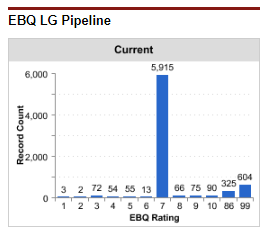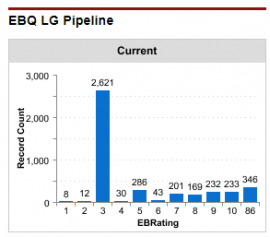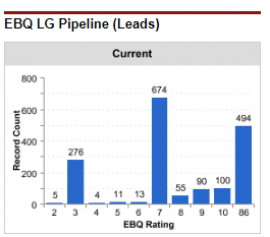Connect with a Consultant
Fill out your information with the form provided and one of our team members will reach out to you shortly.
Cold vs. Hot lead qualification is dead.
It’s time to move on.
The lead qualification stages of cold, warm, and hot are too simple to keep up with the modern tools and strategies that sales development professionals use to secure meetings. You need a lead qualification rating system that replaces and surpasses it, something that will give you better transparency and visibility from the top down.
In this article, we will take a deep dive into lead qualification criteria, process, and tools that will grow your company. Because at the end of the day, proper lead qualification will:
Lead qualification criteria are characteristics that indicate whether a prospect is ready and willing to buy.
Sale development discovers and nurtures these criteria, getting the prospect prepared for a sales meeting if a good fit.
Instead of cold, warm and hot criteria, our sales development team is looking for who, what, where, why and when. These are the questions they need to ask to qualify their prospect for a sales conversation and move the ball forward (we elaborate more on this in our post Best Cold Calling Scripts for Software Sales).
While the framework can be applied to most situations, we recommend you develop your criteria to align with your industry.
It’s important to realize that lead qualification questions and discovery questions are used for different reasons and should be treated that way. A lead qualification question such as “are you the website administrator for your company” is used to qualify the prospect against specific criteria. We use that information to move the conversation to the next step and navigate towards a closed meeting.
In contrast, discovery questions are used to further understand the prospect after they have agreed to set a meeting. For example, when selling web security software we use discovery questions such as “how many endpoints does your company have” to understand the prospect’s environment more and fill out our lead summary for our sales team.
The problem with traditional lead qualification isn’t that it’s one dimensional, it’s that it lacks the granularity and visibility of a more comprehensive description. In a traditional database, you’re putting all of your contacts into three buckets: cold, warm, and hot.
What if you had a contact who won’t be ready to buy for a year, is he warm or cold?
This process doesn’t clearly define what each bucket represents and lack granularity when trying to evaluate a database. You need an efficient lead qualification system that explains precisely where every lead is in the sales lifecycle. This is where a modern lead qualification system comes in.
Our lead qualification approach—which we have dubbed the EBQ Rating—expands on cold vs. hot while taking into account the additional dimensions of modern lead qualification. The idea here is that we have a standardized process for our entire sales team that documents interest and shows how close they are to closing.
EBQ Rating | Label | Description | Next Steps |
| 0 | Sales Qualified Lead | Researched and vetted decision maker that has set a meeting. | Close, close, close. |
| 1 | Very Interested, Closing On Meeting | A decision maker who has expressed interest in meeting and who meets the criteria for your offering but the meeting hasn’t been booked yet or is in reschedule status. | Push for setting or rescheduling a meeting date. |
| 2 | Interested | An interested decision maker who meets the criteria and asked for more information but isn’t ready to arrange a meeting. | Pass along information and warm them up. |
| 3 | Warm Lead, Not Yet Spoken To | Entry Point: Warm leads come from marketing, typically as an MQL, but have not been spoken to. | Discover why they converted and evaluate if they’re a fit. |
| 4 | Point of Contact, Not Yet Spoken To | Your contact passed you to another point of contact in the company to discuss your offering. | Call and mention who referred you, and evaluate if they’re a fit. |
| 5 | Follow up Short Term | A prospect who’s not ready to meet, but could be in 2-12 months. | Use a cadence cycle and apply touches over time. |
| 6 | Follow Up Long Term | A prospect who’s not ready to meet, but could be in a year or more. | Use a cadence cycle and apply touches over time. |
| 7 | Cold Call | Entry Point: A name on a list, no one has called them. You don’t know much else about this contact other than publicly available information. | Call and discover. If they’re not the decision maker, find out who is. |
| 8 | Unsubscribe | A person who has given a verbal or written request to be removed from your database. | Remove this person from your call lists and emails. There are severe legal and financial penalties from ignoring these requests, such as CAN-SPAM. |
| 9 | Referral Contact | A contact who was not the right person to speak with but has passed you to the correct point of contact. | If they could provide you with the right contact, make sure that you mention them when engaging with the new contact. |
| 10 | Unqualified Company | This company doesn’t meet the project criteria. For Example, you sell Pardot training, and they use Hubspot. | Don’t delete the company and contact from your database. You need to know not to reach out to them again about that offering. |
| 86 | Bad Contact Information | Bad work phone and email, or they are no longer with company | Remove the wrong information and put it in the comments for that contact. Comment if they’re no longer with the company. |
| 99 | Relegated Contact |
| Once a contact has been relegated you can safely leave them alone. |
First Touch (Mark, 7)
The SDR reached out to Mark and finds out that both his email and phone number are out. He checks LinkedIn and sees that Mark moved companies.
Mark goes from a 7: Cold Call to a 86: Bad Contact Information
Second Touch (Angela, 7)
Calling Angela, our SDR learns that she isn’t the decision maker. However, Jorge was promoted to Mark’s old position and that he should be the decision maker.
Angela goes from a 7: Cold Call to 9: Wrong Contact
Jorge goes from a 7: Cold Call to 4: Point of Contact Known
Third Touch (Jorge, 4)
The SDR has a call with Jorge. Jorge has a need, but it’s lower priority than the more significant projects he’s working on. He may be ready soon and isn’t sure.
Jorge goes from a 4: Point of Contact Known to 5: Follow up Short Term
Fourth Touch (Jorge, 5)
During your cadence cycle, Jorge downloads one of your ebooks which turns him into an MQL.
Jorge goes from a 5: Follow Up Short Term to 3: Warm Lead
Fifth Touch (Jorge, 3)
The SDR connects with Jorge on a regular basis, passing along information as needed. Jorge appears to be getting more interested but isn’t quite ready to set a date for a meeting.
Jorge goes from a 3: Warm Lead to 2: Interested
Final Touch (Jorge, 2)
After a few more weeks, the SDR speaks with Jorge and sets a meeting.
Jorge goes from 2: Interested to 0: Sales Qualified Lead.
You might be wondering if this system is just classification. You’re not wrong, all we’re doing is segmenting our prospects based on where they are in the sales development cycle. However, that’s what makes it so useful; it’s a simple way of seeing how your contacts are doing. Moreover, when applied to a database, we can measure the health of your sales pipeline.
Now that we have a process for qualifying leads, let’s take a look at some tools we can use to make lead qualification easier. These are the tried and true tools that we use on a daily basis to drive efficient pipeline growth:
There are dozens if not hundreds of CRMs out there. However, we prefer to handle all our sales development from within the industry standard-bearing: Salesforce.com. It’s a robust CRM that’s equally valuable in both sales and sales development. We create a field in Salesforce for EBQ Rating where we can log where our prospect is in the lead qualification process. That way we can quickly filter and segment our database. Also, we have other custom fields added as needed to manage industry-specific information.
Whatever you use, make sure it has the flexibility to work with your pipeline and will help you stage your prospects for effective nurturing.
Marketing automation tools are incredibly useful for nurturing many prospects will little upkeep. For example, we use our Pardot for email automation, landing pages, forms, gated content, and more. We have another point system in the background that adds together point values for the different actions people take on our site. When they cross a certain point threshold, they’re converted to an MQL and automatically mark them as a 3 in Salesforce.
While there are dozens of Marketing Automation tools (and almost all of them integrate with Salesforce), we recommend Pardot as it has the deepest integration with Salesforce and one of the most powerful platforms in the industry.
Interested in Pardot? Our staff of experts and consultants have handled dozens of Pardot implementations for our clients, learn how we can help your business grow with Pardot.
Here are three databases that are segmented using our lead qualification strategy:

This database is relatively fresh and will need to go through a few sales cycles to process these 7s.

Similar to the previous database, this is a database with a large number of new prospects. 3s (MQLs) are a lot like 7s, as they are an entry point, except that 3s have already shown interest in your company.
These 3s will require an aggressive cadence cycle to keep warm.

As you can see, using a modern lead qualification process won’t just help you understand where a prospect is in your sales pipeline, it will also help you diagnose your database and discover problems with your sales development strategy, database or messaging. EBQ has a great deal of experience working with companies’ databases and evaluating their database health. We’re always willing to have a conversation and take a look. If you want to look deeper into analytics around appointment setting, read our post SDR Metrics That Will Make Your Team Successful.
We know that these lead qualification criteria, process, and tools have made a difference in our business, and now it’s time to apply these strategies to yours. Take the time to evaluate your lead qualification pipeline, and see how our proven tactics will help grow your business.
If you’d like to learn more about sales development and appointment settings insights, read our Ultimate Guide to B2B Appointment Setting.
Fill out your information with the form provided and one of our team members will reach out to you shortly.
6800 Burleson Road
Building 310, Suite 265
Austin, TX 78744
©EBQ 2023 All rights reserved.
Tell us about yourself and we’ll get in touch shortly.
